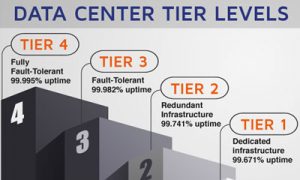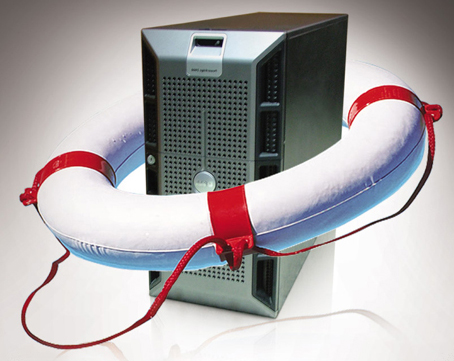Data Center Tiers
Data Center tiers are an efficient way to describe the infrastructure components being utilized at a business’s data center. Although a Tier 4 data center is more complex than a Tier 1 data center, this does not necessarily mean it is best-suited for an organization’s needs. While investing in Tier 1 infrastructure might leave a business open to risk, Tier 4 infrastructure might be an over-investment.
Tier 4 Data Center: A Tier 4 data center is built to be completely fault tolerant and has redundancy for every component. It has an expected uptime of 99.995% (26.3 minutes of downtime annually).
Tier 3 Data Center: A Tier 3 data center has multiple paths for power and cooling and systems in place to update and maintain it without taking it offline. It has an expected uptime of 99.982% (1.6 hours of downtime annually).
Tier 2 Data Center: A Tier 2 data center has a single path for power and cooling and some redundant and backup components. It has an expected uptime of 99.741% (22 hours of downtime annually).
Tier 1 Data Center: A Tier 1 data center has a single path for power and cooling and few, if any, redundant and backup components. It has an expected uptime of 99.671% (28.8 hours of downtime annually).

Tier 4 Data Center Requirements
- Zero single points of failure – Redundancies for every process and data protection stream. No single outage or error can shut down the system.
- 995 % uptime per annum
- 2N+1 infrastructure (two times the amount required for operation plus a backup) – Fully redundant
- No more than 26.3 minutes of downtime per annum – Some downtime is allowed for optimized mechanical operations; however, this annual downtime does not affect user operations.
- 96-hour independent power outage protection – This power must not be connected to any outside source and is entirely proprietary. Some centers may have more.
Tier 4 is considered an enterprise-level service. Tier 4 has approximately twice the site infrastructure of a Tier 3 location.
If you need to host mission-critical servers, this is the level to use. Tier 4 data centers ensure the safety of your business regardless of any mechanical failures. You will have backup systems for cooling, power, data storage, and network links. Data Center Security is compartmentalized with biometric access controls. Full fault tolerance keeps any problems from ever slowing down your business. This is true even if you host less critical servers in other tier levels.
This tier also ensures optimized efficiency. Your servers are housed in the most physically advantageous locations. This drastically extends the life of your hardware. If the temperature and humidity are kept consistent, you gain a great deal of efficiency. Even the backups and dual power sources are treated like primaries.
.
Tier 3 Data Center Requirements
- 982 % uptime per annum
- N+1 fault tolerance (two times the amount required for operation plus a backup) – Ability to undergo routine maintenance without a hiccup in operations. Unplanned maintenance and emergencies may cause problems that affect the system. Problems may potentially affect user-facing operations
- No more than 1.6 Hours of downtime per annum – Downtime is allowed for maintenance and overwhelming emergency issues.
- 72 hours independent power outage protection – at least three days of exclusive power. This power cannot connect to any outside source.
Tier 3 provides most of the features of a Tier 4 infrastructure without some of the elite protections. For instance, the data center has the advantage of dual power sources and redundant cooling and the network streams are fully backed up. Guaranteed uptime is slightly less than Tier 4, and the system is not entirely fault-tolerant.
Tier 2 Data Center Requirements
- 741 % uptime per annum
- No more than 22 Hours of downtime per annum – There is a considerable jump between levels 2 and 3 regarding downtime. Redundancy is one of the primary reasons for this.
- Partial cooling and multiple power redundancies – A Tier 2 Data center will not have redundancy in all areas of operation. The most critical aspects of its mechanical structure receive priority. These two aspects are power and cooling distribution. Redundancy in these areas is only partial. No part of the system is fault tolerant.
The utility of a Tier 2 Data center is fundamentally different. If your business prioritizes redundant capacity components, then you may want to look at this level of infrastructure.
Tier 1 Data Center Requirements
- 671 % uptime per annum
- No more than 28.8 Hours of downtime per annum – There is a considerable jump between levels 2 and 3 regarding downtime. Redundancy is one of the primary reasons for this.
- Zero redundancies – A Tier 1 Data center will not have redundancy in any part of its operations. Facilities do not have any redundancy guarantees within its power and cooling certification process.
The use of the Tier I infrastructure designed for companies with a need for a colocation data center. This is the most budget conscious option for a business. The infrastructure consists of a single uplink, a single path for power, and non-redundant servers.
The tier classification system is another way of assessing redundancy and uptime reliability as you determine your organizations’ data center needs. Contact Zunesis to talk about your data center needs.
A flood that damages mission-critical equipment is among the worst scenarios a data center can face, offering little hope for a quick fix. On April 13, 2015, the Zunesis team received a “first responders call” from a long-term public sector customer who had the misfortune to experience a broken water main that left their main data center under 2 feet of standing water.
The call for help came at 4 p.m. on a Thursday afternoon. Zunesis joined forces with HP and immediately responded to assess the damage. By the next morning, it was clear that the data center was living on borrowed time. With 18 racks of equipment compromised, it was imperative that the team immediately instigate a full Data center fail-over. Luckily, a secondary data center had just been completed, along with plans started for a full DR site; but those plans were stalled as the organization waited for additional funding to become available.
A two-fold plan was quickly put into place to swiftly expand the new data center to capacity while keeping the damaged data center up and running. The insurance company was immediately engaged to begin the replacement exercise while Zunesis and HP jumped in to “keep the lights on” in the existing data center. Immediately needed were a large supply of extra drives; power supplies; cables; switches; and, most daunting, an emergency 120TB SAN array to move data to safety.
 By Friday morning, emails had been circulated to the highest levels of HPE and Zunesis requesting emergency assistance. Zunesis quickly moved a 3Par 7200 array from its own internal lab to the customer site and expanded an additional 100TB in an emergency drive order to migrate data. HP called in emergency supplies from all over the Americas. Extra drives, power supplies, cables, switches, and even servers arrived throughout the weekend. Within 48 hours, the teams had built up enough reserves to keep the data center live until all of the data could be migrated.
By Friday morning, emails had been circulated to the highest levels of HPE and Zunesis requesting emergency assistance. Zunesis quickly moved a 3Par 7200 array from its own internal lab to the customer site and expanded an additional 100TB in an emergency drive order to migrate data. HP called in emergency supplies from all over the Americas. Extra drives, power supplies, cables, switches, and even servers arrived throughout the weekend. Within 48 hours, the teams had built up enough reserves to keep the data center live until all of the data could be migrated.
Although all IT organizations know that it’s critical to have a solid DR plan and failover Data center in place, the reality is that the Data center spotlight is on monitoring and compliance; and the loss of a main data center is crippling. The second most common cause of catastrophic failures (after electrical) in the Data center is water leaks. Taking the following three steps can help avoid a flood disaster:
- Initial survey to ensure that the location of our data center is not in a flood plain and that the site is well protected from external water sources. Confirm that the fabric of the building is well enough designed and properly maintained to prevent the ingress of rain (even in extreme storm conditions). Check how sources of water inside the building are routed (hot and cold water storage tanks, pipe runs, waste pipes, WCs, as well as water-based fire suppression systems in the office space). Office space above a data center is almost always dangerous from a water ingress perspective.
- Protection to ensure that any water entering the data center does not have the opportunity to build up and cause a problem. If you are really worried, install drains and a sump pump under the plenum floor. Ensure that the floor space is sealed and that all cable routes through partition walls are stopped up to be air and water tight.
- Monitoring is critical in a data center – we absolutely need to be able to detect water under the plenum floor. Generally, water detection systems use a cable that runs under the floor and causes an alarm to be triggered if it comes into contact with water.
Click to find out more about our Disaster Recovery Assessments.

